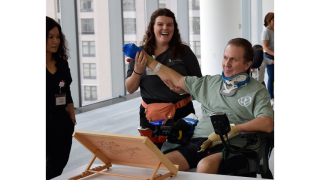Body
Orthostatic or postural hypotension is a sudden drop in blood pressure caused by moving from a lying to a sitting or standing position. It often occurs after spending a long time in bed and then suddenly getting up. Although orthostatic hypotension can happen to anyone, it is more common following a spinal cord injury (SCI). This is because of loss of nervous system control which works to keep the blood pressure stable, as well as loss of muscle tone which helps to return blood to the heart.
Orthostatic hypotension is most common right after an injury and in the first few weeks of rehabilitation. It is more common with cervical and high thoracic (levels 1‑6) spinal cord injuries. In most cases, the problem resolves and only happens after being in bed for long periods of time, and in the morning. For a few people, however, hypotension can continue, and medications may be needed.
How to manage orthostatic hypotension
- Initially, you may need a wheelchair that leans back. The first few times you get out of bed, the back of the chair will be tilted back and then slowly raised to an upright position as you are able to tolerate sitting up.
- An abdominal binder and compression stockings may help to stop the blood pressure from dropping as you sit up.
- If possible, slowly raise the head of your bed and sit up in bed for a few minutes before transferring to your wheelchair.
- Stay active and hydrated, and avoid staying in bed for long periods of time unless medically necessary.
Signs of orthostatic hypotension
- Feeling lightheaded or dizzy.
- Loss of vision or seeing dots before your eyes.
- Loss of hearing or a roaring in the ears.
- Increased sweating or feelings of heart palpitations (fast, forceful heartbeats).
- Fainting.
What to do if you are having orthostatic hypotension
If you are sitting on the edge of the bed before transferring to the wheelchair and begin to feel dizzy:
- Lie down on the bed.
- Apply your abdominal binder or check your abdominal binder to make sure it is tight enough.
- Apply your compression stockings if you are not already wearing them.
- After the dizziness has passed, slowly attempt to sit up on the edge of the bed. Wait to make sure you do not get dizzy again before transferring to the wheelchair. ·
If you are already in the wheelchair when you begin to feel dizzy:
- Place the wheelchair in a reclined position if you have a recliner wheelchair. If not, have someone help tip you back.
- Raise the legs of the wheelchair or have someone help raise your legs to straight position, or higher than your head, if possible.
- Once the dizziness passes, slowly sit up again. Take time in between each movement to see if the dizziness occurs again.
- You may need to do this a few times until your body becomes used to being upright.
- If the dizziness continues, return to bed.
- There are medications that may help raise the blood pressure. If hypotension continues to occur, consult your doctor.
IMPORTANT NOTE: Do not attempt to fight the dizziness. It is not a matter of will power. If you ignore the early signs of hypotension, you might faint. If this happens and you do not assume a reclined position you will deprive your brain of blood and oxygen, possibly causing brain damage.
If you have gone a long period of time without getting dizzy and suddenly find yourself getting dizzy every time you get up, this might be a sign that you have an infection or some other medical problem. Call your doctor.



